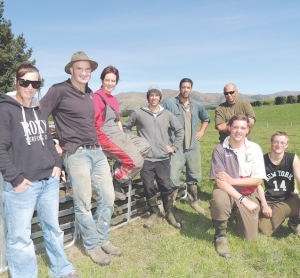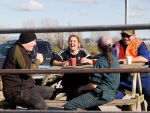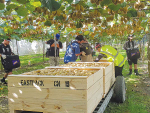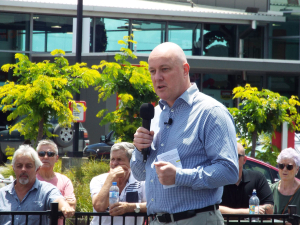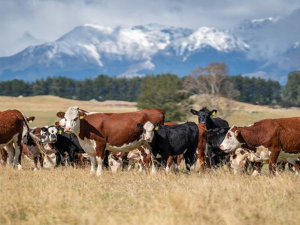FORGET YOUR standard rosters and work out what will work for you and your employees if you want to find, and more importantly keep, good staff.
Such a flexible approach to employment, and investing in their team’s training and futures, is helping South Canterbury dairy farmers John and Cara Gregan get good local staff when many in the area are struggling.
The couple converted part of their former sheep and beef farm to dairying five years ago, putting a 40-aside shed and 450 cows on a previously leased dryland property they’d just bought. Two years later they converted their home farm too, with 550 cows and a 48-aside shed.
It’s an unashamedly low cost approach, producing a touch over 1100kgMS/ha and 400kgMS/cow with farm working expenses budgeted at $3.65/kgMS.
But while every cost has been scrutinised and in many cases cut in light of the lower forecast payout this year, one area they won’t prune is their people. “It’s too important,” says Cara. “You might save thirty or forty thousand but you just put pressure on everyone and everything else.”
Each farm has a manager and they employ an overall operations manager, Wayne Pritchard, with them since before their dairying days.
Officially, the roster is 12 and two, but by adding six days of annual holiday, all the stat days, and six extra days, it becomes 11 and three for all but the first couple of months of the season.
“Even for the first month-and-a-half of the season when we’re calving it means everybody has at least a day off per week. For the juniors it’s usually taken as a full day but the managers usually take two half days,” explains Cara.
“For the rest of the year they get three days in the fortnight, and those days are always over a weekend, either Friday to Sunday, or Saturday to Monday. It means they have a business day off when they can do all their banking and town stuff if they need to, and the weekend which is when most people want to socialise.”
It’s with the juniors that the flexible hours come in. One works 5am to 1pm, another starts 9am and finishes 5pm. The ‘job share’ arrangement means they now only need two relief milkers, where they used to have four.
One of the farm managers’ wives works as a milk harvester 6-9am, and, owing to injury to another staff member, is also helping with calves this year.
“But everybody milks, and everybody helps with the calves. It means if we have someone off on either farm for whatever reason we have cover for them.”
Having slightly more staff than the bare minimum also means less pressure on everybody, making for better working conditions across the board and less risk of burnout.
It’s a lesson they learnt the hard way from a promising young employee a few years back. That’s also why they encourage staff to have a life off the farm, playing sport or some other community involvement.
“One of our juniors just got an award from the local school for coaching their basketball team. How many dairy farm workers have time to do that sort of thing?” Gregan asked the Dairy NZ visitors rhetorically.
Another strategy making for better working conditions is not to have too many cows going through the sheds, so milking is done in a couple of hours maximum, and not to start too early. “We cup on at 6am and 2.30pm so nobody is out before 5am.”
Labour costs come in at just over 90c/kgMS but as Cara points out, that includes everything from calf rearing costs to ACC and training allowances. “It’s really hard to compare like with like.”
All staff complete at least one training course a year.
“Josh and I have just done a welding course,” Pritchard told Dairy News during the Dairy NZ visit. It’s testament to the farm’s work-life balance that they were able to do the six week evening class course starting in the middle of calving.
Pritchard and his wife Kirsty are on an “unconventional sharemilking arrangement” as Gregan puts it. They can add 10 cows/year to the herd of their own, up to a maximum of 50. Currently they have 32, including a couple of dries. “Their expenses are our expenses.”
The managers got a big bonus last year and this year the whole team’s on board looking to make cost savings, well aware the farms are facing a $1.2m income hit.
Two quads were traded in for two-wheelers, yielding savings in capital, fuel and maintenance. “We can do most of the maintenance on the two-wheelers ourselves whereas with the four-wheelers you could be looking at $500/service.”
Each farm still has one four-wheeler but they’re only used for calving, dusting or when they’re safer than a two-wheeler, such as on slippery races. “But most of the time the two-wheeler’s safer.”
Some big savings have been made in animal health too, for example, using CIDR sponges twice and identifying cull cows at calving so they don’t get metri-checked, served or any non-essential treatment. “If they get mastitis they might get one treatment but after that they’ll be gone.”
Every paddock has been soil tested yielding fertiliser savings. Reviewing insurance, banking and accounting arrangements has also saved money.
Cara’s already capitalising on the offers from Fonterra’s recently launched Farm Source initiative. “We’ve saved $50/month with Telecom – that’s $600/year – and it looks like we’ll make big savings on fuel too.”
Claiming the duty on petrol is another trick they’ve realised they’d been missing. “We don’t have any petrol cars which makes it easy as all the petrol goes in the farm bikes.”
From an initial budget of $3.83/kgMS they got it down to $3.64/kgMS at the start of the season, assuming 390kgMS/cow, but given a decent summer and production over 400kgMS/cow, plus extra savings they’re finding on the way, John says he thinks they’ll be able to drive that under $3.50/kgMS.
The whole team gets an update every two months on actual costs versus budget to date “so they know what every cost is as we go through, and they know we’re facing $1.2m off the top line,” adds Cara.
While it’s not a new economy measure, starting the season with just one shed, then opening the second one once 400 cows are in milk, typically about September 1, yields another saving, as does the farm’s unusual “replacement” policy: rearing and selling all heifer calves in December-January then replacing them with empty would-be second calvers in May. “Cost-wise it’s pretty much a straight swap” notes Gregan.
Tips for Staffing Strategy
Understand people’s drivers and needs.
Ensure employees ‘fit’ farm culture.
Use telephone and email to pre-screen applicants.
Recognise staff social needs with free weekends.
Work-life balance for all.
All inclusive team meetings.





